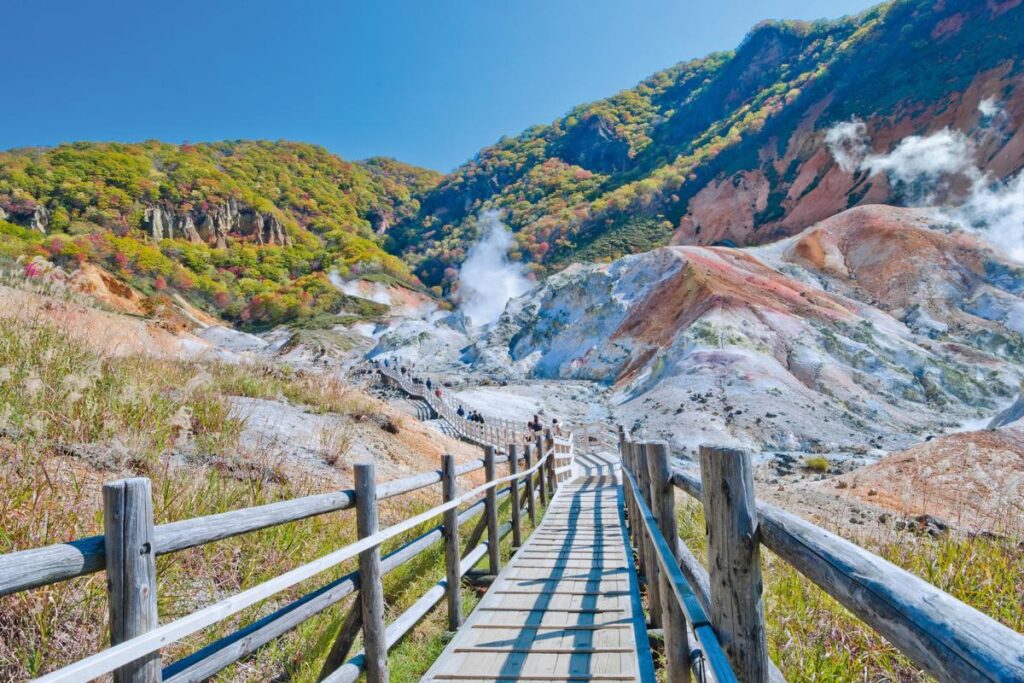This article is produced by National Geographic Traveler (United Kingdom).
Straddling four tectonic plates, Japan’s landscape bends and tears under the vagaries of the fiery Pacific Rim. The result is dramatic: a beautiful, ever-changing crust that concertinas, gurgles and splits into undulating mountains, hot springs and ocean trenches.
This tour explores the best of the country’s contrasting landscapes. It begins in Hokkaido, the northernmost part of the archipelago, and ends in the islands of Japan’s southern Okinawa Prefecture. Hokkaido reaches a latitude of 45°N and can receive 50 feet of snow in winter, while Ussuri brown bears shake off their shaggy fur in spring.
A day on the bullet train south brings travelers to the center of Honshu Island, where the Japanese Alps soar into the sky. Whitewater rafters can race through the hills, while hikers tackle treacherous peaks or wander along picturesque ancient trade routes.
Flights to Naha from Tokyo or Osaka then take you to Okinawa, where the Japanese mainland gives way to a subtropical archipelago of green turtles and white sand. Once home to the Ryukyu Kingdom, it later became a battlefield in World War II and is now a haven for snorkelers and divers.
Highlights
1. Daisetsuzan National Park
Hokkaido’s wild interior is home to Japan’s largest national park, nicknamed “the playground of the gods.” An inferno of sulfur and obsidian rock, seasonal blooms, and belching terracotta calderas, it’s a region of isolated onsen (hot springs) and scene-stealing treks. Climb the 7,516-foot Asahidake stratovolcano, traverse canyons, and spot local wildlife including scampering brown bears and the anime-inspiring pika, a round-eared rabbit relative.
2. Noboribetsu
In Shikotsu-Toya National Park, Noboribetsu on the southwest coast is one of Japan’s best onsen resorts. The town’s ryokan (traditional inns) are fed by geothermal water, while the streets are lined with comical demon statues in a nod to Jigokudani (“Valley of Hell”), a barren white-and-red landscape to the north.
3. The Japanese Alps
The best whitewater rafting can be found on the eastern side of the Japanese Alps on the Tone River, with tours departing from the town of Minakami. Japan’s second-longest waterway cascades down from Mount Ominakami in a blast of snow-cold foam, with rapids rated Class 4+ in spring, dropping to Class 1-2 in summer. After drying off, head some 120 miles (190 kilometers) west into the mountains to hike the ancient Nakasendo trade route through cypress forests around the town of Magome, or tackle the formidable peaks at Kamikochi.
4. Kerama Islands
A half-hour boat ride west of Okinawa’s namesake main island, a handful of smaller islands make up Kerama-shoto National Park. With brilliant aquamarine seas, they’re a popular day trip and offer some of Japan’s best diving and snorkeling — but it’s worth staying overnight at a local guesthouse. Stroll from Zamami Island’s white-sand beaches to turtle-infested waters, dive the reefs of Aka Island for lionfish and pufferfish, and watch nursing humpback whales from the windswept shores (December to April). seasir.com
5. Janbaru
While southern Okinawa is largely devoted to Ryukyu culture and war memorials, the north is full of winding jungle. This UNESCO-protected national park area, called Yanbaru, is home to endangered and endemic species including the flightless Okinawan rail and the Ryukyu giant long-tailed rat. A highlight is the 40-minute forest hike to Hiji Falls. In northern Yanbaru, visit the vast banyan trees of Daisekirinzan, a natural sanctuary.
Published in the September 2024 issue of National Geographic Traveler (United Kingdom).
To subscribe to National Geographic Traveler (UK) magazine click here(Only available in certain countries).

